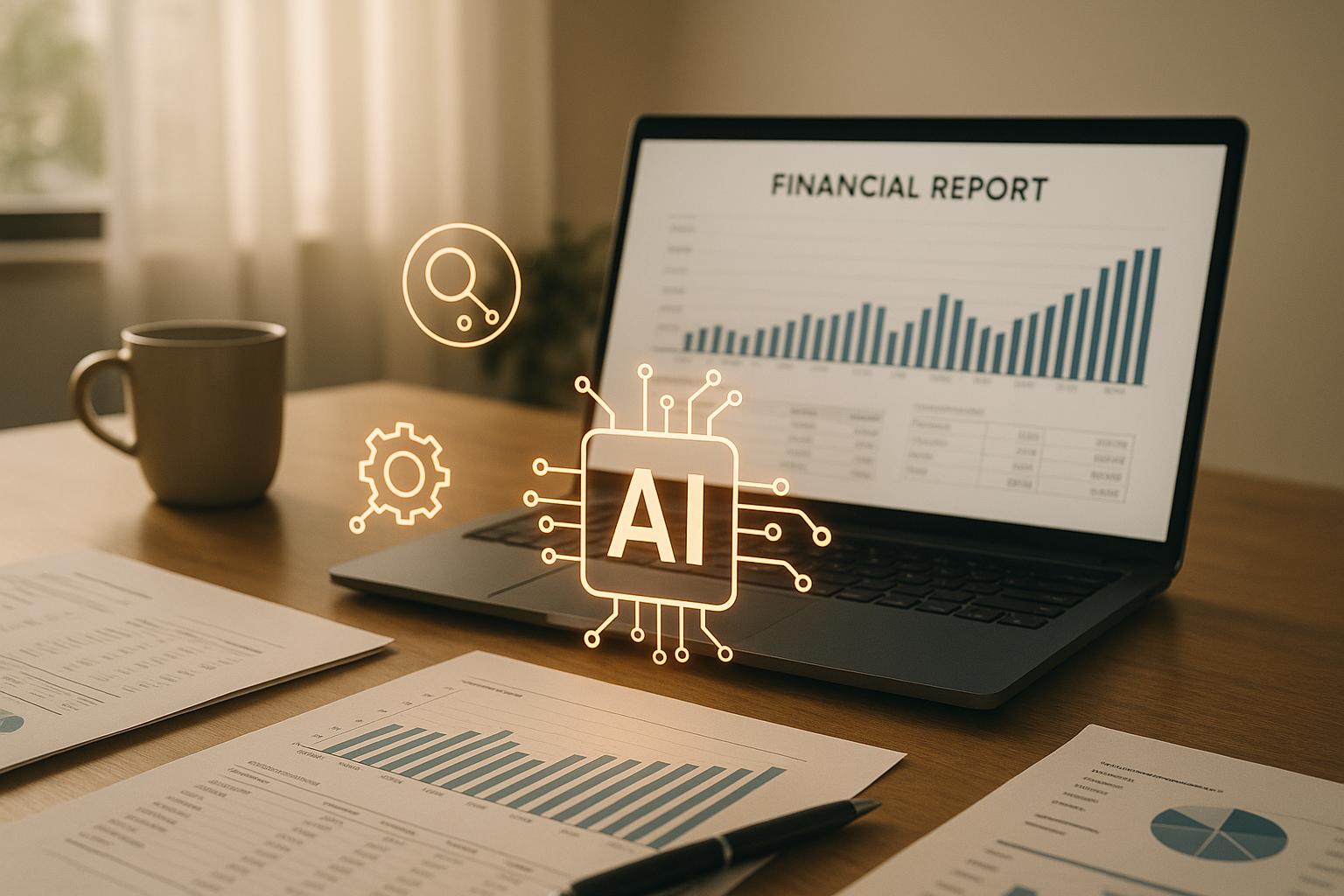How AI Enhances Error Detection in Financial Reporting

AI has transformed financial reporting by automating error detection and fraud prevention, reducing manual effort, and improving data accuracy. Key takeaways:
- Faster Error Detection: AI processes vast amounts of financial data in minutes, identifying anomalies and discrepancies that manual reviews might miss.
- Anomaly Detection: Machine learning models spot unusual patterns, such as unexpected expense spikes or irregular transactions, minimizing false positives.
- Automated Reconciliation: AI matches data across ledgers, bank statements, and invoices, even when minor inconsistencies exist, saving time and effort.
- Real-Time Reporting: Continuous data validation enables up-to-date financial insights, improving cash flow management and decision-making.
- Fraud Prevention: AI flags suspicious activities, like duplicate invoices or unusual employee expenses, in real time, allowing immediate action.
For growth-stage companies, AI simplifies financial processes, supports scaling, and ensures reliable reporting - critical for securing funding and maintaining stakeholder confidence.
How AI Detects Errors in Financial Reporting
AI leverages advanced algorithms to catch errors that might slip past manual reviews. These systems not only detect obvious mistakes but also uncover subtle patterns and connections that could signal deeper issues.
AI-Powered Anomaly Detection
Machine learning models are particularly skilled at identifying when financial data strays from expected patterns. For instance, Isolation Forest algorithms can pinpoint data points that deviate significantly from normal behavior. Imagine expenses suddenly spiking without a corresponding increase in revenue - AI would flag this as an anomaly.
Autoencoders, on the other hand, learn the usual patterns in data, compress and reconstruct it, and then highlight any significant deviations as potential errors.
One major benefit of these systems is their ability to minimize false positives. Unlike traditional rule-based systems that might flag every large transaction as suspicious - creating unnecessary noise for finance teams - AI models use historical data to differentiate between routine transactions and those that truly require attention. This precision in anomaly detection lays the groundwork for automating more complex financial processes.
Automated Reconciliation Systems
Building on anomaly detection, AI also simplifies the process of data matching and reconciliation across multiple sources. Tasks like manually comparing figures in financial reports can be tedious and time-consuming, but AI-powered reconciliation systems handle this with ease. They cross-check data from general ledgers, bank statements, and accounts payable and receivable records, quickly spotting discrepancies.
These systems use smart matching algorithms to identify transactions even when there are minor inconsistencies in naming. For example, if one system records a payment to "ABC Corp" and another lists it as "ABC Corporation", AI can recognize them as the same transaction.
AI also accounts for timing differences. For instance, if a check is issued at the end of one month but clears in the next, the system identifies this as a legitimate timing variation rather than an error. This reduces unnecessary alerts and ensures the focus remains on genuine issues.
The speed of these systems is a game-changer. What used to take days of manual effort can now be completed automatically, allowing finance teams to concentrate on resolving actual problems rather than routine data matching.
Financial Relationship Validation
AI ensures that financial relationships across reports and entities remain mathematically consistent. These systems verify critical connections, like ensuring debits equal credits, cash flow statements align with balance sheet changes, and consolidated financial statements properly eliminate intercompany transactions.
Automated checks cover every aspect of financial records. For example, if the net income reported on the income statement doesn’t match the change in retained earnings on the balance sheet after accounting for dividends, the system pinpoints the discrepancy and traces its origin.
In multi-entity organizations, AI validates transactions across subsidiaries to ensure accurate consolidation - a task that would be nearly impossible to do manually.
AI also enhances ratio analysis, digging deeper than basic calculations to uncover inconsistencies that don’t align with broader business trends. For instance, if accounts receivable grow disproportionately compared to sales, the system flags this for investigation. These detailed checks catch errors that might otherwise go unnoticed until much later in the reporting process.
With these capabilities, AI helps maintain the integrity and consistency of financial data across all reports.
Real-Time Financial Reporting with AI
Traditional financial reporting often operates on monthly or quarterly cycles, which means errors can linger undiscovered for weeks. With AI, businesses can process data continuously, flagging discrepancies as they occur. This allows finance teams to generate accurate reports in real time, eliminating the need to wait for month-end close procedures.
This shift from periodic to continuous reporting transforms how companies monitor their financial health. Instead of identifying issues weeks after they arise, AI systems catch and alert teams to problems immediately. This drastically reduces the time and effort required to maintain accurate financial records. Let’s explore how automation and continuous data processing make this possible.
Automated Financial Tasks
AI removes manual bottlenecks by automating repetitive financial tasks like journal entries and routine transactions. For instance, it can handle payroll, recurring expenses, and revenue recognition by applying preset rules and analyzing historical data.
Take monthly rent payments as an example: AI can automatically debit the rent expense, credit cash, and update related budget tracking and variance reports - all without human intervention.
Reconciliation processes also benefit from automation. Instead of waiting until the end of the month, AI continuously matches bank transactions, credit card activity, and internal records. Using techniques like fuzzy matching, it can reconcile vendor payments even when minor discrepancies exist, such as slight name variations or differences in amounts. This capability is particularly useful in accrual accounting, where AI tracks outstanding invoices, pending payments, and timing gaps between cash flows and revenue recognition. The result? Financial statements that stay up-to-date throughout the month.
Continuous Data Processing
AI doesn’t just automate tasks - it ensures that financial data is always current. Traditional batch processing requires teams to gather, validate, and process data in large chunks, often at month-end. AI, on the other hand, validates incoming data in real time, offering a live view of financial performance.
This real-time processing has a significant impact on cash flow management. Finance teams gain instant visibility into receivables, payables, and cash positions, allowing them to monitor daily cash flows, spot potential shortfalls ahead of time, and make informed decisions about payments, collections, or short-term financing needs.
Continuous data processing also enables real-time variance analysis, comparing actual performance against budgets so that corrective actions can be taken immediately. For multi-entity organizations, AI dynamically consolidates financial data by processing intercompany transactions, currency conversions, and elimination entries in real time. This ensures consolidated financial statements always reflect the latest performance.
Regulatory compliance benefits as well. AI continuously monitors transactions for potential violations or reporting issues, helping companies address problems proactively rather than reactively.
For growth-stage companies, this level of visibility is invaluable. Continuous data processing helps them track key metrics like customer acquisition costs, lifetime value, and burn rates on a daily basis. This real-time insight empowers management to make agile decisions, particularly when working with partners like Phoenix Strategy Group, who specialize in scaling businesses.
AI-Based Fraud Detection
When it comes to fraud detection, AI goes far beyond catching routine errors. Traditional methods, like periodic audits and manual reviews, often fail to detect sophisticated schemes. In contrast, AI can sift through massive amounts of financial data to uncover patterns that might escape even the sharpest human reviewers.
Fraud can take a heavy toll on businesses, sometimes eating into a significant chunk of their annual revenue. AI-powered tools help limit these losses by identifying fraudulent activities early, stopping them before they spiral out of control.
Pattern Recognition for Fraud Detection
AI works by learning what "normal" business activity looks like, making it easier to spot unusual transaction patterns. It analyzes historical data to establish benchmarks for things like transaction amounts, frequency, vendor relationships, and approval processes. Any transaction that deviates significantly from these norms gets flagged for review.
Machine learning algorithms are especially adept at catching subtle red flags - things like invoices that hover just below approval thresholds or transactions occurring at odd hours. These are the kinds of details that traditional rule-based systems often miss.
AI also excels at detecting duplicate payment fraud. Fraudsters might submit the same invoice multiple times, tweaking details like vendor names, invoice numbers, or amounts to avoid detection. Using fuzzy matching, AI can identify these duplicates even when the changes are slight.
Expense fraud is another area where AI shines. By analyzing employee expense patterns, it can flag anomalies like unusually high meal costs or excessive mileage claims. Similarly, for vendor fraud, AI monitors payment trends and vendor relationships over time, identifying suspicious new vendors or unexpected changes in payment details for existing ones.
These capabilities allow companies to act quickly, minimizing the damage caused by fraudulent activities.
Real-Time Fraud Response
AI doesn't just detect fraud - it does so in real-time. This immediacy is critical for preventing small issues from snowballing into major problems. By monitoring transactions as they happen, AI enables finance teams to step in much faster than traditional audit cycles would allow.
For example, when AI spots a suspicious payment, it can automatically pause the transaction for manual review or require additional approvals. This kind of instant response is especially important for preventing high-stakes issues like wire transfer fraud.
AI systems also assign risk scores to transactions, helping teams prioritize their efforts. High-risk transactions get immediate attention, while lower-risk ones continue without interruption. This ensures smooth business operations while maintaining a strong fraud defense.
The technology integrates seamlessly with existing approval workflows, adding an extra layer of security without disrupting day-to-day processes. For instance, if AI flags a potentially fraudulent invoice, it can automatically route it to senior finance staff for further review, gather supporting documents, and flag related transactions for additional scrutiny.
Behavioral analytics add another layer of protection. By tracking user behavior - like login times, transaction types, and approval patterns - AI can trigger alerts when employees act outside their usual habits. This helps catch fraud attempts as they happen.
For companies in growth phases, especially those working with financial advisory firms like Phoenix Strategy Group, AI-powered fraud detection provides critical financial safeguards. It ensures transparency and operational efficiency, which are essential for maintaining investor confidence and protecting resources during periods of rapid change.
sbb-itb-e766981
AI Benefits for Growth-Stage Companies
Growth-stage companies face unique financial hurdles as they navigate rapid expansion. Unlike established firms with well-oiled systems, these businesses must juggle building reliable reporting processes, managing investor expectations, and handling limited resources - all while scaling quickly. Add to that the surge in transaction volumes that often accompanies growth, and it’s easy to see how bottlenecks can threaten critical milestones like funding or acquisitions. This is where AI steps in to streamline operations and boost transparency.
Improved Operational Efficiency
AI takes the grunt work out of manual reconciliation, freeing up hours that finance teams can redirect toward high-priority initiatives like market expansion, product innovation, and investor relations. By validating data in real time, AI ensures accuracy while scaling effortlessly alongside transaction growth - no need to hire additional staff to keep up.
Cash flow management also improves significantly. AI can flag discrepancies in accounts receivable and payable early, helping businesses avoid surprise cash crunches that might otherwise force hasty fundraising or sudden budget cuts. Plus, it reduces the typical end-of-month scramble by continuously monitoring financial records, giving leadership timely, accurate insights to make better decisions.
For companies working with advisory services, AI lays the groundwork for more strategic partnerships. With routine tasks like error correction and data validation largely automated, advisors can shift their focus to higher-value activities such as market analysis, scenario planning, and crafting growth strategies.
Better Financial Transparency
While AI enhances day-to-day efficiency, its ability to improve transparency is just as impactful. Automated error detection creates a reliable audit trail, ensuring data integrity and reinforcing financial controls - key factors during due diligence or investor evaluations.
AI-powered dashboards provide real-time, continuously verified financial metrics, eliminating the need to rely solely on periodic reports that might later need adjustments. This level of clarity not only strengthens investor trust but also empowers leadership to act quickly on market opportunities or challenges with confidence.
Beyond that, AI offers a detailed view into business performance by identifying error patterns across product lines, departments, or regions. These insights can highlight areas for improvement, enhance customer satisfaction, and optimize processes. Staying compliant with evolving financial regulations also becomes more manageable, as AI systems document controls and track adherence systematically.
Firms like Phoenix Strategy Group use AI-driven transparency to deliver specialized services, including fractional CFO support and M&A guidance. With validated financial data at their fingertips, they can accelerate due diligence and achieve more accurate business valuations - leading to better outcomes for their clients.
Conclusion: AI's Future in Financial Reporting
AI is reshaping financial reporting by improving accuracy, speeding up processes, and adding a layer of fraud prevention. With its ability to catch errors and streamline reconciliation, AI saves time and reduces manual effort.
One of the standout features of AI is its real-time monitoring. Instead of waiting for end-of-period reviews, AI can instantly identify and address financial discrepancies as they happen. This proactive approach is especially valuable for growth-stage companies, allowing them to scale operations without the burden of increasing overhead costs.
AI’s pattern-based fraud detection offers an essential safeguard as businesses handle a growing number of transactions and more complex financial structures. By spotting unusual patterns in real time, AI provides a level of security that traditional methods simply can't match in terms of speed or scope. This added layer of protection supports both operational efficiency and financial stability.
When integrated into financial processes, AI doesn’t just improve day-to-day operations - it lays the groundwork for sustainable growth. For companies in their growth phase, adopting AI early ensures they can scale efficiently without the usual headaches of manual error corrections or delayed financial reporting. Real-time insights become a powerful tool for making informed decisions and avoiding costly mistakes.
The financial advisory field is also evolving alongside these advancements. For example, firms like Phoenix Strategy Group are using AI-enhanced financial data to deliver more precise fractional CFO services and M&A advisory support. By working with real-time, validated financial information, they can accelerate due diligence and offer more accurate business valuations. This shows how technology complements human expertise rather than replacing it.
Looking ahead, AI’s capabilities will only expand. Expect smarter error detection, seamless integration with existing systems, and predictive tools that help businesses foresee and prevent financial challenges before they arise. Early adopters of these technologies will gain a clear advantage in areas like growth, securing funding, and successful exits.
For growth-stage companies, the question is no longer if they should implement AI in financial reporting - it’s how quickly they can act to stay ahead in a data-driven business world.
FAQs
How does AI reduce false positives in financial anomaly detection?
AI is transforming financial anomaly detection by cutting down on false positives. Instead of relying on rigid, rule-based systems with fixed criteria, AI employs advanced algorithms to analyze historical data and adjust its accuracy in real-time. This ability to adapt and recognize intricate patterns means fewer unnecessary alerts and sharper detection.
With fewer false positives, AI boosts compliance efforts and streamlines operations while minimizing disruptions for customers. It's a powerful asset for delivering precise and dependable financial reporting.
How can AI-driven real-time financial reporting help growth-stage companies succeed?
AI-powered real-time financial reporting is transforming how growth-stage companies handle their financial data. By using advanced algorithms, it identifies errors and inconsistencies quickly, cutting down on manual work and reducing the chances of human error. This not only saves time but also ensures data accuracy and compliance - key factors in building trust with stakeholders.
Real-time updates allow businesses to make smarter, faster decisions. Whether it’s managing risks, streamlining operations, or planning for future growth, having up-to-the-minute financial insights is a game-changer. This is particularly important for companies looking to scale, attract investors, or prepare for significant milestones like acquisitions or exits. With AI-driven tools, these companies can stay agile and competitive in fast-paced markets.
What makes AI more effective than traditional audits and manual reviews in detecting fraud?
AI has become a game-changer in fraud detection, offering sharp precision, real-time tracking, and the ability to handle massive data loads effortlessly. Unlike traditional audits, which happen periodically and can be prone to human oversights, AI works around the clock, scanning enormous volumes of financial data. It picks up on subtle irregularities and patterns that manual reviews might completely overlook.
By automating repetitive and time-consuming tasks, AI not only lightens the load for human teams but also speeds up the detection process. This means organizations can act quickly when suspicious activity arises, enhancing financial security and staying aligned with regulatory requirements. On top of that, AI cuts down on false alarms, ensuring resources are directed toward actual threats, making the entire process more efficient and focused.




